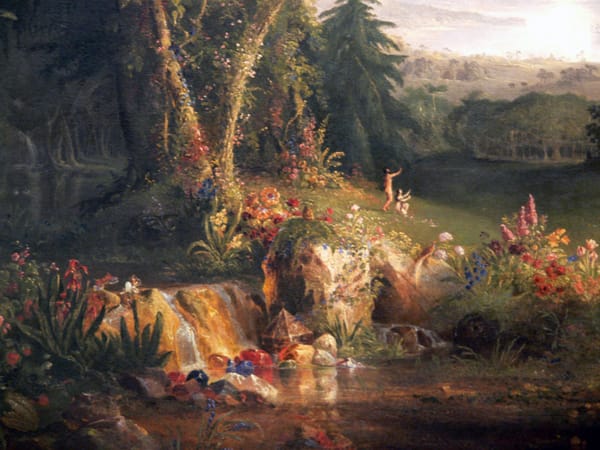Dayagons are the Bestagons
An immodest rebuttal of the any-mile hex, for the map is not the territory, and time is a flat hexagon.

Being agreeable is bad for blogging business. My esteemed colleagues have posited variously 3-mile or 6-mile hex sizes are optimal for mapping a campaign world:
- In Praise of the 6 Mile Hex
- The Ergonomic 3 Mile Hex
- Down With The 6 Mile Hex! A Modest Proposal
- Et cetera
These arguments revolve around the geometric and dimensional properties of orienteering and measuring travel distance across these hexagons, and how that relates to sightline to the horizon. This is understandable, but quite frankly doesn't hold water when the rubber hits the road... or something. Let's break down some of the purposes a region map should serve, and see why day-wide hexagons really are the bestagons.
Travel
Most hexmaps are keyed fairly sparsely: even at a relatively intimate 3-mile scale, they tend to feel barren in play, because translating from the map and key to an experiential journey as relayed via the senses asks a huge lift of the GM.
When I am running the game, I don't have a perfect simulation of the world running in my head, resolving travel distance and sight lines to decimal precision. Outside of setting up a battlemat or grid for a spot of the old ultraviolence (read: wargaming), space in play is malleable - stretching, squishing, slouching to accomodate our imaginings. Observe that in all interactions, a liminal space must be glossed over: street to street or district to district in a town, or moving room to room in a dungeon, or even moving between salient objects or conversant non-player characters within a single room.
One of the reasons that adventure modules are so popular is the format of a map and detailed keys (whether read-aloud text or just sufficient notes to be relayed by the GM without too much off-the-cuff creativity). Each keyed room is a point of interest, and play flows well for all concerned by exploring within a point and then moving along to another. A very common adjustment in modern play from early D&D is abstraction of movement pace in exploration: often it is assumed a 10 minute 'turn' elapses moving into a new adjacent room or by performing a significant action, and the tracking of 120 ft segments seems quaint.
An awkward series of steps and conversions must exist when we consider travel between points of interest in terms of miles: we need to have a travel pace for the party, modified by terrain difficulty and other factors, and often count hours or watches (usually 4-6 hour increments) through each day before a 'make camp' procedure. This invariably adds tracking of state and some accounting, and means a few times each imagined day we need to solicit the party for a current heading, yet I find this often breaks flow and doesn't present particularly meaningful or interesting choices. We wouldn't stop a player moving across a room to ask "you are now mid-way crossing the dining room, do you still want to head North to the door, or do you want to head East to the stone wall, or West where you just came from?" They would rightly reply "I just want to go to the next room - tell me when I get there!"
The natural increment of overland travel is the day - it's how you think about your own journeys, selecting a series of reasonably spaced stops to sleepover. It's also (though this should matter less) more consistent with how someone in-world would think about their journey - before GPS and mobile phones with Map apps, you would just know you can make the walk from Abbington to Bruxenfort from dawn to dusk, or can head as far as the old mill while still getting home before dark.
What of terrain difficulty or mounts? The latter is simple: horses improve carrying capacity but don't change the speed of travel - this is eminently gameable and reasonably realistic to boot. The former is also simple, but more contentious - the harder the terrain within a hex, the smaller the true space covered. A hex of swamp is smaller in geometric terms than a clear field - yet to the person traversing it, they take the same amount of time. Of course this raises some thorny questions if you start trying to plot exact routes through the edges and vertices of each hexagon, but the point is - you don't. Stick to atomic hexes as the unit of abstraction, and let imaginations elide the minor discrepancies.
Exploration
I treat travel separate to exploration. Travel is about getting from your origin to your destination via a plotted route, and though you may have encounters and make detours, it is ultimately a means to an end. Conversely, exploration is its own end, and to be worthwhile requires sufficient density of ideas and experiences in play.
I would strongly argue that you can't make a hexmap of only terrain types and sparse keys very interesting to explore - you just need more content. This is analogous to prepping a (mega)dungeon, and is well discussed in Re-Inventing the Wilderness. To my mind, the best hexmap for exploration in publication that I have seen is Dolmenwood (though Hot Springs Island and Neverland are both also excellent, sharing similar qualities). The hexes are densely keyed, with each location having one or more fairly detailed points of interest. These are intended as allowing traversal of 2-3 hexes per day, but would absolutely function as written at 1 hex per day.
Another good approach is seen in Nightmare Over Ragged Hollow: the adventure presents 3 detailed hexes, each containing several points of interest, and the paths between those are assigned a number of hours of travel. This would be a great way to further detail a day-wide hex when you want play to zoom in, such as searching a forest or swamp for a forgotten temple or crypt entrance.
World-Building
This is the clincher for me, so I've saved it for last. Prior to the widespread deployment of automobiles, we naturally spaced human settlements in large part based on travel and trade patterns. This leads to many old towns being a day's walk from their neighbour(s), and also means that dependent smaller settlements (villages and hamlets) cluster within a half-day of a town to permit travel to-and-fro. A keep needs to project force through military patrols, and these again can reach as far out as a half-day's ride to permit return within camping out.
Day-wide hexagons provide the most convenient division of space for creating and playing with geopolitics. Whatever the largest settlement or fortification is can be assumed to exist in the approximate centre of the hexagon, providing suitable spacing from those others nearby, and making it clear the region of land they can directly control. Projecting force (ie rulership) beyond the immediate hexagon usually requires a satellite settlement or fortification, which seems quite intuitive (though perhaps exceptional cases like guards with flying mounts could be entertained). This makes domain play, so often observed in the breach, just a little bit more accessible: clear a single hex of opposing interests and you can claim your patch of land.
Conclusion
Inevitably, Mr Bastionland has somewhat beaten me to the punch on this one, as Chris McDowall's Mythic Bastionland presents a similar (yet subtly distinct) notion: the Hecksleague, which he describes as:
- The area a hill fort can overlook
- The area that guards can patrol in a day
- A return hike to a neighbouring Hex gets you home before dark
The difference here is only that as implied by point #3 (and later spelled out in his game), you can walk across two Hecksleagues per day. This is ultimately a matter of personal taste, and otherwise all the points above apply equally well to either variation.
Please chime in below or on your own blog: are you a Dayagon convert, a true believer? Or will your slide rule and protractor be pried from your cold, calculating, dead hands?




